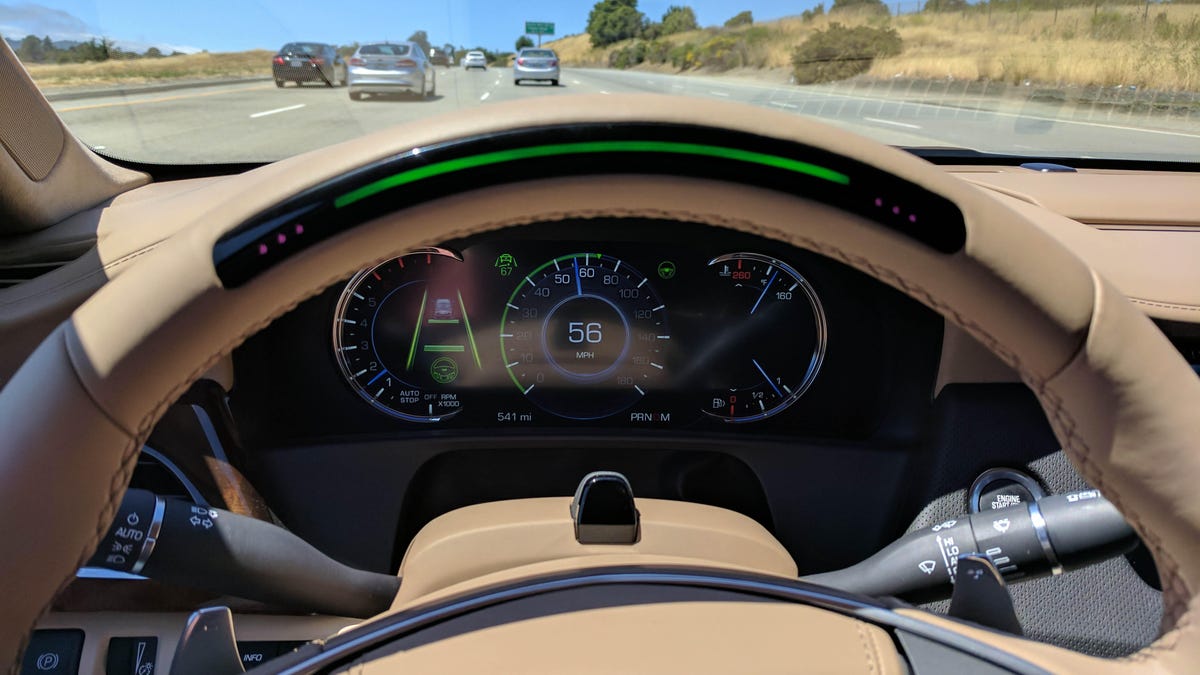We went hands-off with Cadillac's Super Cruise on public roads
We tested Caddy's upcoming highway autopilot system on public roads and were impressed by its refinement.

Super Cruise is Cadillac's upcoming highway autopilot system that allows drivers to go truly hands-free on the freeway. This tech will be offered as an option on the Cadillac CT6 later in 2017, but we got a very early hands-on hands-off demo this week on public roads near Roadshow's San Francisco HQ.
Settling into the driver's seat, I found there aren't many visual indicators that betray that this CT6 is any different from the one I drove last year. That's because the Super Cruise system makes use of the same sensors that make adaptive cruise control and lane-keeping systems possible, which makes sense because it's basically a highly evolved version of those technologies. On the surface, the only visible changes are a small driver-facing infrared camera on the steering column and a glossy black indicator light strip on the steering wheel.
After easing the car down the on-ramp into highway traffic, I accelerated to my cruising speed of about 65 mph. An icon appeared in the digital instrument cluster to let me know that Super Cruise was ready to take over. I tapped a button on the steering wheel and, once the indicator strip on the steering wheel turned green, let go of the wheel.
The first thing that stood out to me was just how smooth the Super Cruise's steering was. Cadillac uses forward-looking cameras to detect the left and right lane markers, averaging these boundaries to estimate the invisible centerline of the lane. Cadillac's engineers call this the "blue line." By following the blue line, Super Cruise is able to smoothly follow the lane, rather than ping-ponging between the boundaries.
How Cadillac's Super Cruise worksWe took a ride with Cadillac's Super Cruise the other day and were impressed with its refinement.
Posted by RoadshowAutos on Thursday, June 29, 2017
Like current adaptive cruise control systems, Super Cruise is able to maintain a set following distance behind a car ahead. So, when traffic slowed to 35 mph, the Cadillac slowed to match. Super Cruise isn't able to automatically pass a slower-moving car, but I was able to simply grab the steering wheel at any time to regain control. This simple act, it turned out, was the bit that impressed me the most about Super Cruise.
In even the best lane-keeping and autonomous systems I've tested, there's an odd resistance in that fraction of a moment between my applying steering force and the steering system relinquishing control. It's not much, but it adds a hair of jerk to the transition that I always notice. Super Cruise's transition from machine to human steering is so seamless, so smooth, that I didn't even notice that it was happening.
An indicator light built into the steering wheel lets me know at a glance when Super Cruise is engaged and steering.
When I wanted to pass a slower car or change lanes, I simply grabbed the wheel. The moment my fingers hit the leather, capacitive sensors in the wheel detected my touch and prepared to return control to me. When I turned the wheel, the system smoothly and instantly disabled the steering assistance. While I was in control, the green indicator bar on the wheel pulsed blue, and once I was centered in the next lane it returned to a solid green to let me know it was OK to let go again. The whole process was just amazingly natural with zero mechanical resistance.
Super Cruise is a hands-free system, not an eyes-free one; so the driver must stay engaged and looking ahead. That small infrared camera mentioned earlier is there to watch my head and face and make sure I'm watching the road. I could look away for a few seconds to fiddle with the infotainment, grab a drink or look around and chat with my passengers, but if I looked away for too long the system would draw my attention forward again with lights and audible warnings. (I honestly had a hard time forcing myself to look away long enough to trigger the warning; decades of vigilant defensive driving made me too nervous.)
Behind the scenes, Cadillac employs ultraprecise, lidar-measured maps of the road network, which the car compares against GPS and the cameras' virtual blue line as a Super Cruising confidence check. If everything lines up, you can cruise away. If not, then the system won't activate or, if it's already engaged, the driver will be prompted to regain control. This fail-safe means that vandals can't just spray-paint lines on the highway to trick the cameras, but also that tricky situations like road construction will require driver control. I'm okay with that.
Super Cruise joins the CT6 Sedan's options list later this year.
My Super Cruise test drive took me from Palo Alto to South San Francisco and back, about a 50-mile round trip, with zero hiccups. It was surprisingly smooth and relaxing and the system was extremely natural to use. I walked away thinking, "I can't wait for this to actually be available."
I won't have to wait too long. The Super Cruise system joins the options list on the 2018 Cadillac CT6 Prestige this fall in the US and Canadian markets. After that, we'll likely see the feature spread to other Cadillac models and ultimately across General Motors' stable of brands. Super Cruising Chevy Volt anyone? I can't wait. Pricing for the feature has not yet been announced.

